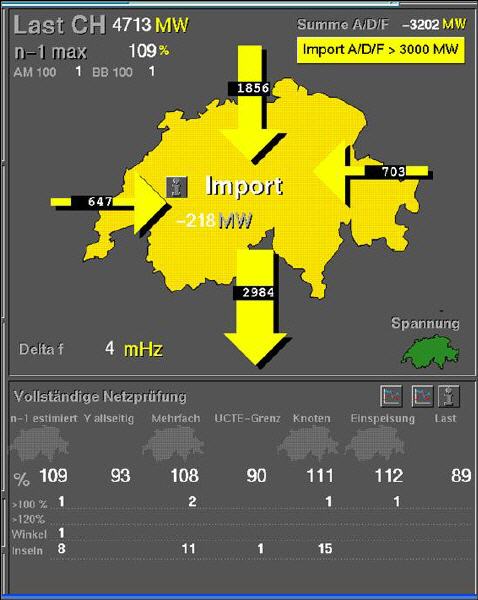|
|
 |
 |
 |
 |
 |
OCD Online Contingency Diagnosis |
|
Within seconds, not minutes or hours, the safety situation of large high-voltage networks as operated by transmission system operators (TSO) can be assessed and results displayed in real time. The software has been specially designed and optimised for the cyclic and automatic online security evaluation of the online network in a TSO control without any human intervention.
ISPEN/OCD is a vital tool required to fulfil the UCTE requirement of 'N-1' secure operation (Policy 3).
Many companies claim to fulfil these requirements . In isolated situations they may do so.
However, in the tightly linked and truly dynamic European network this is just not good enough . Any TSO must take into account the risks of surrounding network contingencies.
ISPEN uses the UCTE data interchange format as a standard for the estimated state and the model. Data generated in different formats (e.g. by state estimators) are converted to UCTE format. The ISPEN/OCD part runs on a dedicated host where the contingency list of the security network is processed. The results calculated are condensed to a set of simple security indices for immediate evaluation. The cycle is repeated as soon a new state estimation is available.
ISPEN/OCD has an extremely fast response time. In a reference installation, a list of about 2'000 cases is calculated in about 20 seconds - on a normal PC - for the UCTE reference network 2004/2005 which has about 6'000 nodes and about 9'000 branches.
Solving network equations is a well known mathematical process, and the full AC Newton-Raphson method is used by the OCD iteration process. However, the blunt approach cannot be used for real time calculation. The matrix to be solved is growing by the square of the number of nodes (144’000’000 elements in the example above). ISPEN uses powerful algorithms for sparse matrices to reduce the amount of calculations to those that are significant. These algorithms have been optimised for more than thirty years.
Switch - in Angle The switch-in angle is the phase angle difference between two nodes that will be used for the re-closing of the switches of a line or transformer that has tripped due to overload, discharge, lightning strikes or other reasons. When this angle is exceeding the settings of the device, the automatic re-closing device will be inhibited, preventing an in-service restoration of the branch. The switch-in angle calculation is incorporated in the ISPEN/OCD contingency diagnosis both as angle in degrees and as angle in % of the setting of the re-closing device. Two of the final security indices result from those calculations.
N-1 Contingency List The contingency list processed by ISPEN/OCD can be composed by any combination of single and/or multiple outage cases. This allows for such individual lists as:
n-1 -> Single branch outage
g-1 -> Outage of generation .
b-1 -> Outage of bus-bars
n-k -> Outage of parallel branches or a group of branches.
Thus, all major types of contingencies are covered. For cases causing loss of generation or load a distributed slack is used to restore the power balance.
Cascading risks can be evaluated by ISPEN/OCD as an option.
Security Indices The following eight security indices are the standard output from ISPEN/OCD:
max. loading [%]
# N-1 > 100%
# N-1 > 120%
# Angle > 100 %
# max. angle [°]
# Isolated injections
# Network split
# Cases not solved
All indices except for max. loading and max. angle are counters. Thus, index #3 shows how many branches there are with a loading factor greater than 120 %.
ISPEN/OCD is available on PC running under Linux or Windows and/or on Alpha Stations running OpenVMS. It can be integrated in any network running TCP/IP, FTP or DECNET protocols and can thus be integrated in virtually any TSO operated LANs and WANs. The system, once set up, does not need any manned interaction. For large systems, multiple parallel processors can be used for even faster calculation cycles. A reference installation runs at the Swiss TSO in Laufenburg.
|
|
The screenshot below shows the representation of some results from ISPEN/OCD by the SCADA System of Swissgrid in Laufenburg, Switzerland:
|
|




|
|
 |